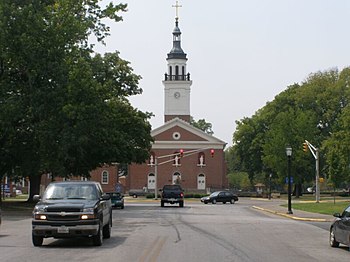 |
| A picture of Pisgah Baptist Church in Four Oaks, North Carolina, USA. (Photo credit: Wikipedia) |
 |
| English: Banagher Presbyterian Church and Sunday School The building on the right is the church hall which was built in 1900, hence its name "The Century Hall". The church on the left of the picture was built earlier, in 1825, by the Fishmonger's Company, one of the London Companies. (Photo credit: Wikipedia) |
 |
| A simplified chart of historical developments of major groups within Christianity. (Photo credit: Wikipedia) |
If you have decided
that you need to find a new church or are looking for the first time to attend
a church the search can take a while. Generally, you can only really visit one
church a week. Below are some things to think about in your quest to find the right
church home.
You should spend sometime writing down what your belief
are . Simply find a church that somewhat lines up with your personal beliefs
are not enough. Some people also are looking for a church to help them define
their personal belief.
Write down what you believe and what your family values
are. Then make a list of things you have spiritual questions about. You can
later use this list to examine the doctrines of a church that interests you. It
is wise to remember you will never find a church that line up a hundred percent
with your personal beliefs. Most people are best served looking for a church
that in general lines up with their personal view of Christianity. Think about
how much separation you are willing to tolerate between church doctrine and
your personal belief. Obviously, a church has to teach the things that you want
your children exposed too. You need to look at how important it is to you to
have your children have the same Christian perspective as you do.
Once you have a well defined understanding of what you
believe now is the time to do your homework. The Internet is a great place to
research what denominations believe. Most sites maintained by the various
denominations have a statement of belief or doctrines on their web sites. If
the theological jargon on these sites does not make what the group believe,
clear to you , go a step father and join a Yahoo email group for people of that
faith. Most people will be more than willing to answer your questions about
their church. Doing this online can be less intimidating to you and you will
find yourself being very honest when you are corresponding by email about these
groups faith beliefs.
The next step to finding a church is to know what you want
in an individual congregation. Is your family best suited for a small church or
a large church. Your teen may not be excited attending a small church with no
youth group. Some congregations are truly "dying" and cater to senior
citizens that have attended that congregation for years. These churches have
their value. They will value having the chance to get new members. They will
shower your younger kids with all kinds of individual attention. They can be a
great place to attend if you can live without programming geared to younger
families and teens.
There are churches that are actually called 'program
churches' and can have literally thousands of members They try to create a
personal atmosphere by encouraging people to involve themselves in small groups
with people who are of a similar demographic. They have programs for divorced ,
single, and married couples. Most of these churches have extensive Christian
education programs and teen ministries. There is something for everyone and if
you are looking for a church to have activities for your whole family then
these kinds of churches may be great for you. The down side , is the social
atmosphere is somewhat artificial and maybe you do not get to know people from
varied background.
The next thing, you should look at is what opportunities
the church offers you to do lay ministry. Some large churches have so much
staff you can only really get involved with individual short term charity
projects. This would be a good choice for families that are very busy but still
want to give time to the church. Smaller churches always need volunteers from
working in the office , helping with the food pantry, or teaching Sunday
school. If you want to be able to participate in ministry on a weekly basis,
the smaller congregation might be the most satisfying place to be.
When the Sunday comes to go church shopping; try to have
as many household members who you want to attend with you present. You cannot
make a decision about a final church home unless you can get everyone's
feedback. Finding a church you love and your kid's are totally bored at will
just lead you to have fights about them getting up early to go to church Sunday
mornings.
Remember picking the right church home is important. Most
of us mark the major events in our lives; birth , marriage , and death in a
church. Picking the right church for your family takes a little effort but it
can really end changing our lives in very major ways.








































